《国际经济学》课程教学课件(讲稿)第3章 国际贸易标准理论 The Standard Theory of International Trade
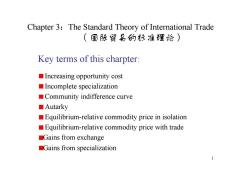
Chapter 3:The Standard Theory of International Trade (国际贸易的标准理论) Key terms of this charpter Increasing opportunity cost Incomplete specialization Community indifference curve ■Autarky Equilibrium-relative commodity price in isolation Equilibrium-relative commodity price with trade ■Gains from exchange Gains from specialization
1 Chapter 3:The Standard Theory of International Trade (国际贸易的标准理论) Key terms of this charpter: Increasing opportunity cost Incomplete specialization Community indifference curve Autarky Equilibrium-relative commodity price in isolation Equilibrium-relative commodity price with trade Gains from exchange Gains from specialization
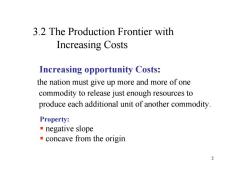
3.2 The Production Frontier with Increasing Costs Increasing opportunity Costs: the nation must give up more and more of one commodity to release just enough resources to produce each additional unit of another commodity. Property: negative slope concave from the origin 2
2 3.2 The Production Frontier with Increasing Costs Increasing opportunity Costs : the nation must give up more and more of one commodity to release just enough resources to produce each additional unit of another commodity. Property: negative slope concave from the origin

3.2A Illustration of Increasing Costs Y Nation 2 B Nation 1 140 △Y 120 100 80 60 △Y 40 △X 汤 01030507090110130 0 Production frontier of nation 1 and nation 2 with increasing costs Absolute slope of the production frontier at the point of production- Marginal Rate of Transformation(边际转换率) 3
3 Production frontier of nation 1 and nation 2 with increasing costs 3.2A Illustration of Increasing Costs -△ Y 0 10 30 50 70 90 110 130 Y Nation 1 X △ X A B 140 120 100 80 60 40 20 0 - △ X Y Nation 2 △ Y X A’ B’ Absolute slope of the production frontier at the point of production—— Marginal Rate of Transformation (边际转换率)
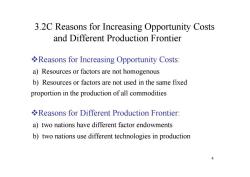
3.2C Reasons for Increasing Opportunity Costs and Different Production Frontier Reasons for Increasing Opportunity Costs: a)Resources or factors are not homogenous b)Resources or factors are not used in the same fixed proportion in the production of all commodities Reasons for Different Production Frontier: a)two nations have different factor endowments b)two nations use different technologies in production
4 3.2C Reasons for Increasing Opportunity Costs and Different Production Frontier Reasons for Increasing Opportunity Costs: a) Resources or factors are not homogenous b) Resources or factors are not used in the same fixed proportion in the production of all commodities Reasons for Different Production Frontier: a) two nations have different factor endowments b) two nations use different technologies in production
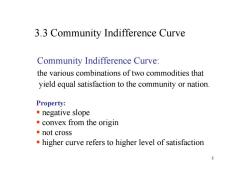
3.3 Community Indifference Curve Community Indifference Curve: the various combinations of two commodities that yield equal satisfaction to the community or nation. Property: ■negative slope convex from the origin ■not cross higher curve refers to higher level of satisfaction 5
5 3.3 Community Indifference Curve Community Indifference Curve: the various combinations of two commodities that yield equal satisfaction to the community or nation. Property: negative slope convex from the origin not cross higher curve refers to higher level of satisfaction
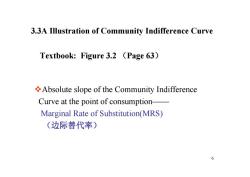
3.3A Illustration of Community Indifference Curve Textbook:Figure 3.2 (Page 63) Absolute slope of the Community Indifference Curve at the point of consumption Marginal Rate of Substitution(MRS) (边际替代率) 6
6 Textbook: Figure 3.2 (Page 63 ) 3.3A Illustration of Community Indifference Curve Absolute slope of the Community Indifference Curve at the point of consumption—— Marginal Rate of Substitution(MRS) (边际替代率)

3.4 Equilibrium in isolation In the absence of trade,a nation is in equilibrium at the point where a Community Indifference curve is tangent to the nation's Production frontier
7 3.4 Equilibrium in isolation In the absence of trade, a nation is in equilibrium at the point where a Community Indifference curve is tangent to the nation’s Production frontier

3.4A Illustration of Equilibrium in isolation B国 140 120 A国 100 80 1% 80H 60 40 40 20 01030507090110130X 0 140 20406080858 孤立均衡时,A国的生产可能性曲线与无差异曲线相切于A点, 即国内均衡点,福利最大化。同样B国的均衡点为A'。 8
8 3.4A Illustration of Equilibrium in isolation 孤立均衡时, A国的生产可能性曲线与无差异曲线相切于 A点, 即国内均衡点,福利最大化。同样 B国的均衡点为A’
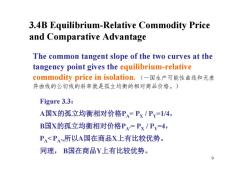
3.4B Equilibrium-Relative Commodity Price and Comparative Advantage The common tangent slope of the two curves at the tangency point gives the equilibrium-relative commodity price in isolation.(一国生产可能性曲线和无差 异曲线的公切线的斜率就是孤立均衡的相对商品价格。) Figure 3.3: A国X的孤立均衡相对价格PA=Px/P=1/4, B国X的孤立均衡相对价格PA=Px/P=4, PA<PA,所以A国在商品X上有比较优势。 同理,B国在商品Y上有比较优势。 9
9 3.4B Equilibrium-Relative Commodity Price and Comparative Advantage The common tangent slope of the two curves at the tangency point gives the equilibrium-relative commodity price in isolation. (一国生产可能性曲线和无差 异曲线的公切线的斜率就是孤立均衡的相对商品价格。) Figure 3.3: A 国 X的孤立均衡相对价格 P A= P X / P Y=1/4, B 国 X的孤立均衡相对价格 PA’= P X / P Y=4, P A< PA’,所以 A国在商品 X上有比较优势。 同理, B国在商品 Y上有比较优势

3.5 The Basis for and the Gains from Trade with Increasing Costs The difference in relative commodity prices between two nations reflects their comparative advantage and forms the basis for mutually beneficial trade. lower relative commodity price higher relative commodity price comparative advantage comparative disadvantage 10
10 3.5 The Basis for and the Gains from Trade with Increasing Costs The difference in relative commodity prices between two nations reflects their comparative advantage and forms the basis for mutually beneficial trade. lower relative commodity price comparative advantage higher relative commodity price comparative disadvantage
按次数下载不扣除下载券;
注册用户24小时内重复下载只扣除一次;
顺序:VIP每日次数-->可用次数-->下载券;
- 《国际经济学》课程教学课件(讲稿)第2章 比较优势理论 The Law of Comparative Advantage.pdf
- 《国际经济学》课程教学课件(讲稿)第1章 导论 International Economics(重庆工商大学).pdf
- 《国际经济学》课程授课教案(讲义)国际经济学讲义(萨尔瓦多,英文8版).doc
- 《国际经济学》课程授课教案(讲义)国际经济学讲义(林德特11版).doc
- 《贸易经济学》课程教学课件(PPT讲稿)零售贸易.ppt
- 重庆工商大学:《贸易经济学》课程授课教案(讲义,授课教师:陈淑祥).doc
- 重庆工商大学:《贸易经济学》课程教学大纲 Economics of Trade.doc
- 重庆工商大学:《会计学》课程教学课件(PPT讲稿)第四章 财务会计报告的编制与分析.ppt
- 重庆工商大学:《会计学》课程教学课件(PPT讲稿)第六章 会计信息的应用与决策支持.ppt
- 重庆工商大学:《会计学》课程教学课件(PPT讲稿)第五章 信息化背景下的会计核算.pptx
- 重庆工商大学:《会计学》课程教学课件(PPT讲稿)第二章 复式记账法.pptx
- 重庆工商大学:《会计学》课程教学课件(PPT讲稿)第三章 主要经济业务的核算.ppt
- 重庆工商大学:《会计学》课程教学课件(PPT讲稿)第一章 总论.ppt
- 重庆工商大学:《会计学》课程教学实验指导书.doc
- 重庆工商大学:《会计学》课程授课教案(讲义).pdf
- 重庆工商大学:《会计学》教学大纲 ACCOUNTING A.pdf
- 《马克思主义政治经济学》课程教学课件(PPT讲稿)第四章 本积累和资本主义分配制度.ppt
- 《马克思主义政治经济学》课程教学课件(PPT讲稿)第六讲 资本主义市场经济体制与资本主义经济的发展.ppt
- 《马克思主义政治经济学》课程教学课件(PPT讲稿)第八章 资本主义的未来.ppt
- 《马克思主义政治经济学》课程教学课件(PPT讲稿)第五章 资本社会化与资本主义所有制.ppt
- 《国际经济学》课程教学课件(讲稿)第4章 供求、提供曲线与贸易条件 Demand and Supply, Offer Curves, and the Terms of Trade.pdf
- 《国际经济学》课程教学课件(讲稿)第5章 要素禀赋与赫克歇尔-俄林理论(H-O理论)Factor Endowment and the Heckscher-Ohlin Theory.pdf
- 《国际经济学》课程教学课件(讲稿)第6章 规模经济、不完全竞争和国际贸易 Economies of scale, Imperfect Competition, and International Trade.pdf
- 《国际经济学》课程教学课件(讲稿)第7章 经济增长与国际贸易 Economies Growth and International Trade.pdf
- 《国际经济学》课程教学课件(讲稿)第8章 国际贸易壁垒——关税 Trade Restrictions - Tariffs.pdf
- 《国际经济学》课程教学课件(讲稿)第9章 非关税壁垒与新保护主义 Nontariff Trade Barriers and the New Protectionism.pdf
- 《国际经济学》课程教学课件(讲稿)第17章 收入调节机制与自动调节的综合 the Income Adjustment Mechanism and Synthesis of Automatic Adjustment.pdf
- 《国际经济学》课程教学课件(讲稿)第18章 开放经济宏观经济学——调整政策 Open-Economy Macroeconomics - Adjustment Policies.pdf
- 《国际经济学》课程教学课件(讲稿)第20章 浮动与固定汇率、欧洲货币体系与宏观经济政策的协调 Flexible versus Fixed Exchange Rates, the European Monetary System, and Macroeconomic Policy Coordination.pdf
- 《国际经济学》课程教学课件(讲稿)第21章 国际货币体系——过去、现在与未来 the International Monetary System - Past, Present, and Future.pdf
- 《国际经济学》课程教学课件(讲稿)第10章 经济一体化——关税同盟与自由贸易区 Economic Integration - Customs Unions and Free Trade Areas.pdf
- 《国际经济学》课程教学课件(讲稿)第11章 国际贸易与经济发展 international trade and economic development.pdf
- 《国际经济学》课程教学课件(讲稿)第12章 国际资源流动与跨国公司 international resource movements and multinational corporations.pdf
- 《国际经济学》课程教学课件(讲稿)第14章 外汇市场与汇率 Foreign Exchange Markets and Exchange Rates.pdf
- 《国际经济学》课程教学课件(讲稿)第15章 汇率的决定 Exchange Rates Determination.pdf
- 《国际经济学》课程教学课件(讲稿)第16章 可变与固定汇率制下的价格调节机制 the Price Adjustment Mechanism with Flexible and fixed Exchange Rates.pdf
- 《区域经济学》课程教学课件(PPT讲稿)区域经济学导论.ppt
- 《区域经济学》课程教学课件(PPT讲稿)第一讲 区域资源环境.ppt
- 《区域经济学》课程教学课件(PPT讲稿)第七讲 区域要素流动与区际贸易.ppt
- 《区域经济学》课程教学课件(PPT讲稿)第三讲 区域产业结构与产业布局.ppt
